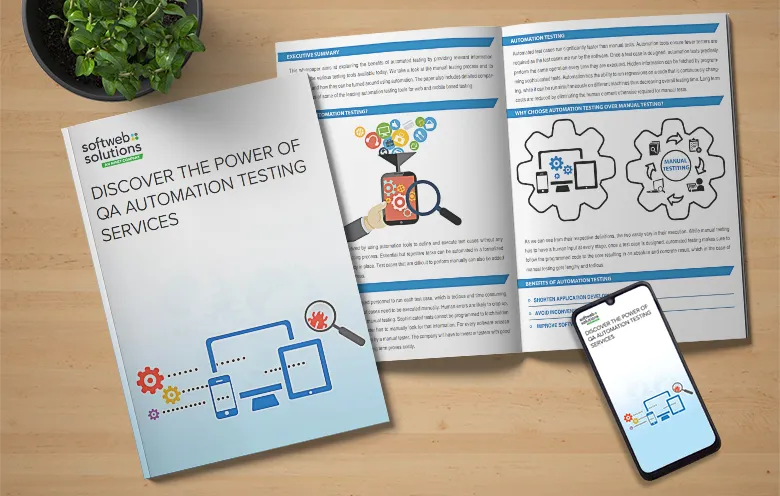
Businesses have realized the importance of software development and quality assurance. To ensure the smooth functioning of software products and applications, testing plays a crucial role.
Automation Testing Market size was valued at USD 19.9 Billion in 2021 and is projected to reach USD 89.81 Billion by 2030. — Verified Market Research
Test automation services have emerged as a game-changer in this arena. It is revolutionizing the way software is tested for functionality, performance and reliability. This article dives deep into the world of test automation, uncovering its services, benefits, best practices and its role in the realm of quality assurance.
What is test automation?
Test automation involves the use of specialized software tools to automate the execution of tests on software applications. Unlike manual testing, where testers execute test cases manually, test automation involves creating scripts that can perform these tests automatically. These speed up the testing process, reduce human error and enhance the accuracy of test results.
Understanding test automation services
Test automation services encompass a range of offerings provided by specialized companies. These services include designing and implementing automated test scripts, integrating testing frameworks and setting up continuous integration and continuous delivery (CI/CD) pipelines. By leveraging these services, organizations can ensure a robust testing process that aligns with their development lifecycle.
Advantages of test automation
- Efficiency: Automated tests can be executed much faster than manual tests, enabling quicker feedback during development.
- Accuracy: Automated tests are consistent and free from human error, leading to reliable and repeatable results.
- Regression testing: Automated tests are ideal for performing regression testing, ensuring that new changes don’t adversely affect existing functionalities.
- Cost savings: While initial setup might require investment, automated testing ultimately reduces the need for extensive manual testing, saving time and money.
Test automation best practices
- Selective test cases: Not all test cases are suitable for automation. Choose test cases that are repetitive, time-consuming and critical for the application’s functionality.
- Regular maintenance: Automated tests require maintenance as the software evolves. Keep scripts up to date to reflect changes in the application.
- Parallel execution: Run tests in parallel to expedite the testing process and obtain faster results.
- Data management: Efficiently manage test data to ensure tests are robust and adaptable to different scenarios.

Insights
Discover The Power of QA Automation Testing Services
Assurance testing. Before the application is made public or sent to the client, it needs to have addressed every issue and bug that might have crept in during the coding of the application. Delegating a dedicated engineer to perform manual tests can get cumbersome.
Exploring Automated Testing as a Service (ATaaS)
Automated Testing as a Service (ATaaS) is a comprehensive solution that offers automated testing capabilities on a cloud-based platform. This service allows teams to access testing infrastructure remotely, enabling seamless collaboration and scalability.
The role of QA software testing companies
QA software testing companies play a pivotal role in driving effective test automation strategies. These companies specialize in providing expertise in test automation tools, frameworks and methodologies. They assist organizations in implementing test automation effectively, thus enhancing the overall quality of software products.
Benefits of QA automation testing
To delve even deeper into the advantages of test automation, consider referring our blog where we have highlighted the benefits of QA automation testing. As seen in this resource from Softweb Solutions, QA automation testing offers substantial advantages that complement the overall software development process. From improved test coverage to quicker time-to-market, these benefits solidify the importance of embracing automation in the testing lifecycle.
Leverage test automation for better quality of your software products
In the ever-evolving landscape of software development, test automation has emerged as an indispensable tool to ensure the quality, reliability and performance of applications. By leveraging test automation services and adhering to best practices, organizations can streamline their testing processes and deliver exceptional software products to their users.
FAQs related to test automation
1. Is test automation suitable for all types of testing?
Answer: Test automation is best suited for repetitive and time-consuming tests, such as regression testing, performance testing and load testing.
2. What are some popular test automation tools?
Answer: Some widely used test automation tools include Selenium, Appium and JUnit.
3. Can test automation replace manual testing entirely?
Answer: While test automation offers efficiency, it’s not a complete replacement for manual testing. Certain scenarios still require human judgment and exploratory testing.
4. How often should automated test scripts be updated?
Answer: Automated test scripts should be regularly updated to align with changes in the application’s functionality and features.
5. What role does continuous integration play in test automation?
Answer: Continuous integration ensures that automated tests are seamlessly integrated into the development process, providing rapid feedback to developers.
Originally published at medium.com on November 23rd, 2023.



























